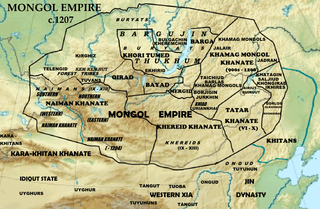Tatar confederation
| Tatar Nine Tatars Татарын ханлиг | |
|---|---|
| 8th century–1202 | |
 Tatar and their neighbours in the 13th century. | |
| Status | nomadic confederation |
| Religion | Shamanism |
| Government | Elective monarchy |
| chief | |
| Legislature | Kurultai |
| Historical era | High Middle Ages |
• Established | 8th century |
• Disestablished | 1202 |
| Today part of |
|
Tatar (Old Turkic: ![]()
![]()
![]()
![]()
![]()
![]()
![]()
![]()
![]()
![]()
![]()
![]()
![]()
![]()
![]()
![]()
![]()
![]()
![]()
The Tatars inhabited the north-eastern Gobi in the 5th century and the Tatars became subjects of the Khitan Liao dynasty in the 10th century. After the fall of the Liao, the Tatars experienced pressure from the Jurchen Jin dynasty and were urged to fight against the other Mongol tribes. The Tatars lived on the fertile pastures around Hulun Nuur and Buir Nuur and occupied a trade route to China in the 12th century.
After the establishment of the Mongol Empire, the Tatars were subjugated by the Mongol Empire under Genghis Khan. Under the leadership of his grandson Batu Khan, they moved westwards, driving with them many of the Turkic peoples toward the plains of Russia in the Turkic migrations.
References
- ↑ "Kül Tiğin (Gültekin) Yazıtı Tam Metni (Full text of Kul Tigin monument with Turkish transcription)". Retrieved 5 April 2014.
- ↑ "Bilge Kağan Yazıtı Tam Metni (Full text of Bilge Khagan monument with Turkish transcription)". Retrieved 5 April 2014.
- ↑ "The Kultegin's Memorial Complex". Retrieved 5 April 2014.
- ↑ Ross, E. Denison; Vilhelm Thomsen. "The Orkhon Inscriptions: Being a Translation of Professor Vilhelm Thomsen's Final Danish Rendering". Bulletin of the School of Oriental Studies, University of London. 5 (4, 1930): 861–876. JSTOR 607024.
- ↑ Thomsen, Vilhelm Ludvig Peter (1896). Inscriptions de l'Orkhon déchiffrées. Helsingfors, Impr. de la Société de littérature finnoise. p. 140.